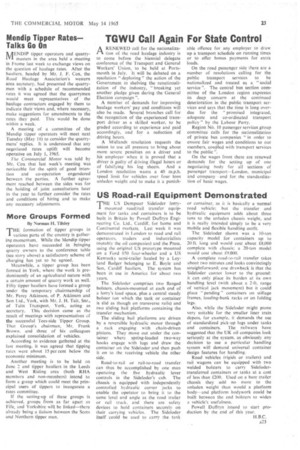US Road-rail Equipment Demonstrated
Page 25

If you've noticed an error in this article please click here to report it so we can fix it.
THE US Dempster Sideloder lorry'. mounted road/rail transfer equipment for tanks and containers is to be built in Britain by Powell Duffryn Engineering Co. Ltd., Cardiff, for home and Continental markets. Last week it was demonstrated in London to road and rail operators, traders and industrialists (notably the oil companies) and the Press, using the original US prototype mounted on a Ford 850 four-wheeler and a US Kentucky semi-trailer hauled by a Leyland Badger belonging to E. Boyle and Son, Cardiff hauliers. The system has been in use in America for about two years.
The Sideloder comprises two flanged bolsters, chassis-mounted at each end of a lorry's load space, plus a central steady bolster (on which the tank or container is slid as though on transverse rails) and two sliding bail platforms containing the transfer mechanism.
The sliding bail platforms are driven by a reversible hydraulic motor through a rack engaging with chain-driven pinions. They move out under the container where spring-loaded two-way hooks engage with lugs and draw the container on the Sideloder and then push it on to the receiving vehicle the other side.
Road-to-rail or rail-to-road transfer can thus be accomplished by one man operating the five hydraulic lever controls in the Sideloder's cab. The chassis is equipped with independently controlled hydraulic corner jacks to enable the operator to bring it to the same level and angle as the road trailer or rail truck, and there are safety devices to hold containers securely on their carrying vehicles. The Sideloder itself could be used to carry the tank
or container, as it is basically a normal road vehicle; but the transfer and hydraulic equipment adds about three tons to the unladen chassis weight, and it is really intended sin-1ply to be a very mobile and flexible handling outfit.
The Sideloder shown was a 10-ton capacity model for containers up to 20 ft. long and would cost about £8,000 complete with chassis; a 20-ton model would cost about £9.000.
A complete road-to-rail transfer takes about two minutes and looks convincingly straightforward; one drawback is that the Sideloder cannot lower to the ground: it can only place its burden at its own handling level (with about a 2-ft. range of vertical jack movement) but it could place ' pending " containers on stillage frames, loading-bank racks or "on folding legs.
Also. while the Sideloder might prove very suitable for the smaller liner train depots, for example, it demands the use of standardized pick-up lugs under tanks and containers. The railways have suggeSted that the UK oil companies look seriously at the system, as obviously any decision to use a particular handling system will demand universal container design features for handling.
Road vehicles (rigids or trailers) and rail wagons can be equipped with two welded bolsters to carry Sidelodertransferred containers or tanks at a cost of less than £200. Used on a bare trailer chassis they add no more to the unladen weight than would a platform body—and platform bodywork could be built between the end bolsters to widen a vehicle's usefulness.
Powell Duffryn intend to start production by the end of this year.
H.B.C. A23




















































































































